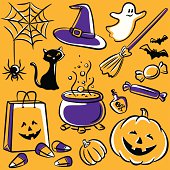History of Halloween

The modern version of Halloween has its roots in Celtic traditions. The holiday has changed through the centuries, reflecting the history of America. Candy, candy apples, candy bags and treats, all part of today's celebration, can be traced to ancient Irish celebrations that came to the U.S. with the waves of immigrants in the 1800's.
Halloween candy has long been part of the American celebration of Halloween. Of Celtic origin, it became Americanized during the 19th and 20th centuries.
History of Halloween
Handing out Halloween candy was not part of the original Celtic celebrations, but many Celtic traditions have shaped the modern version of Halloween. For example, the Celts thought apples could be used to foretell the future, especially in matters of marriage. So apples endure in the modern tradition of candy apples.
Mischief, Mumming, Magic and Treats in Ireland
The Celts celebrated on October 31 with bonfires and mischief. The Celts didn't hand out candy bags, but they did leave treats of food for the spirits of the deceased. They also dressed in disguises, a practice known as mumming. That tradition survives in today's Halloween costumes.
Early American Halloween Traditions
The Puritans frowned on the holiday, but the Irish celebrated it. When these descendants of the Celts came to America during the Irish immigration waves, they brought their Halloween traditions with them. Autumn harvest yielded corn and pumpkins, which early Americans used as decorations. Corn gained special attention in 1898 when the Groelitz Candy Company first produced candy corn. Originally called "Chicken Feed," it quickly became a Halloween candy tradition.
Modern Celebrations
In the mid-20th Century, the tradition of trick-or-treating and Halloween parties was begun in an effort to curb pranks. Decorated bags were presented to those who attended the Halloween parties. Halloween candies and treats, such as chocolate cupcakes with orange frosting, orange sherbet, and licorice were also popular.
Halloween became more elaborate after World War II and the baby boom. By 2009 Halloween candy sales had reached almost $2.1 billion. A century after its introduction, corn shaped candy is still the top seller, with 20 million pounds purchased.
Today's cooks continue to expand traditional Halloween offerings. Along with the usual chocolate cupcakes, a new and popular Halloween candy recipe is a variation on rice cereal treats. The recipe calls for the addition of Halloween candy and chocolate chips, which preserves the traditional orange and black colors.
Many interesting candy facts are associated with Halloween history:
- *M&Ms, a trick-or-treat favorite, originated in 1941 and were first distributed to soldiers.
- *Chocolate kisses were first produced in 1907 though production was halted during World War II due to silver foil rationing.
- *Snickers bars were introduced in 1930 and named for the inventor's horse!
Halloween traditions will continue to change, but Halloween candy will remain a constant, a reminder of those ancient Celtic treats and customs.